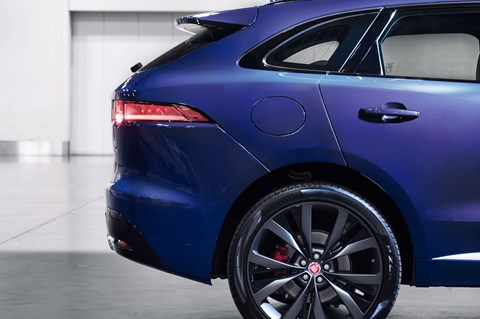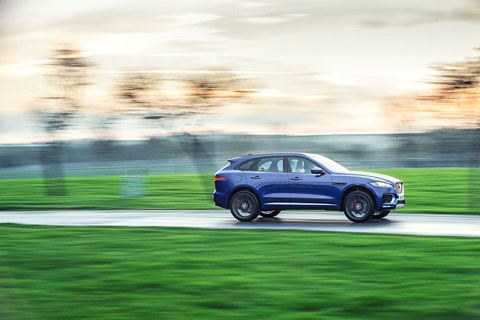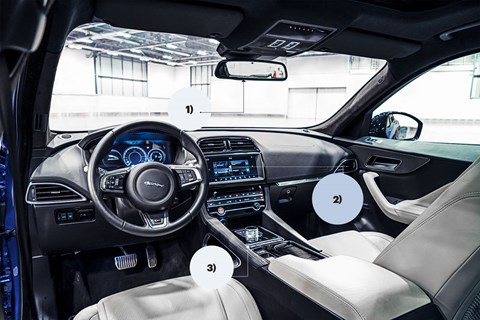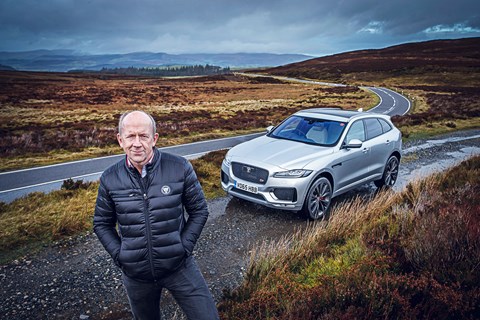► We put Jag’s new SUV through it’s Pace(s)
► Goes tit for tat with Porsche’s Macan
► Hugely capable – both on and off road
The off-road route weaves in and out, over and under The Fosse Way somewhere between Gloucester and Leicester. After morning rain, meadows peppered with spidery Klimt trees glisten like large ponds sprayed with green stardust. This is no slog through the mud and ruts of Land Rover’s Eastnor Castle facility, but then we’re not driving a Defender; this is the new F-Pace, sister brand Jaguar’s first ever SUV.
Time has softened the initially peculiar-sounding name, and indeed the jarring idea of an all-terrain Jaguar. It’s a similar story inside, where seemingly contradictory sports- and off-road cues gel to create a coherent whole. The Big-Foot stance might afford great visibility, but the driver’s seat feels positioned low down, the XE steering wheel strikingly small when presented on this broader canvas. Immediately these cues and the excellent driving position prepare you for a very Jaguar, very sporting kind of sports utility vehicle. And yet in this final prototype sign-off drive, we’re traversing terrain that’d give any other all-wheel-drive Jag serious pause for thought. Talk about a crossover.
The F-Pace’s body rocks gently as we criss-cross the pockmarked surface, suspension taking hits like a selfless bodyguard, all four tyres clawing traction with regal grace. Muted in the background, the muscular V6 turbodiesel remains barely above tick-over, pulling smoothly at a canter, revs gently climbing as gradients increase, the refinement notable. There’s even an engaging, egg-you-on exhaust note permeating the cabin upon more thorough exploration of the torque reserves.
Only the dash architecture lets the side down: we’ve been a little disappointed with both XE and XF cabins, and the F-Pace’s closer juxtaposition with Land Rover products only highlights the deficit. The quality is fine, and the 13 stowage compartments and super-sized door bins are happy to play butler when hands are full, but Land Rover cockpits look more confident, less fussy.
No such problems with the exterior. The Ian Callum-tailored bodyshell stretches to 4731m, slotting neatly between Jaguar’s XE (4672mm) and XF (4954mm) saloons, though closer to the former than the latter. Based on an aluminium-intensive monocoque derived from Jag’s new scalable architecture, F-Pace’s bonnet is aluminium, its doors steel, the boot composite. Underneath, you’ll find double wishbones up front, an Integral Link multi-link axle at the rear, and steel springs all round, just like XE and XF. Adaptive dampers are available – our S has them as standard – but there’s no air-suspension option.
Market positioning is as intriguing as technical detail for F-Pace: it represents the closest that Tata’s British car brands have ever come to treading on each other’s footwear, Jaguar spying an opportunity to enter a market that’s projected to grow 40%, Land Rover glancing nervously in its mirror. But if Jaguar Land Rover’s chief chassis engineer Mike Cross sees a conflict of interests, he isn’t letting on.
‘We didn’t even think of Land Rover during this project,’ he claims, keeping a close eye on proceedings from the passenger seat. ‘Our aim was to be true to Jaguar DNA; our most sporting car is the F-type, followed by the XE saloon. I wanted F-Pace to be like the XE with a flavour of F-type.’
F-Pace, says Cross, is very much a road car, a vehicle never intended to be marketed as an off-roader, but one that has sufficient off-road smarts when duty calls, if not a Land Rover’s outright capability.
‘We use the same test facility as Land Rover, and we’ve tested in Sweden, on Big Red [sand dune] in Dubai, and on gravel tracks at Walter’s Arena,’ says Cross.

Early in its development, F-Pace was benchmarked against the BMW X4, before Jaguar’s focus shifted to Porsche’s baby SUV, the Macan. Check the raw figures and the F-Pace draws first blood. The 3.0-litre V6 S turbodiesel we’re driving promises 296bhp and 516lb ft, which squares up favourably to the Macan’s 254bhp and 428lb ft. Both cars weigh around1800kg, but the F-Pace is 34mm longer – for a large interior and 150 litres of extra boot space. The smaller Macan does fight back, however, with a price tag some £5.5k cheaper in diesel guise.
As Cross has it, ‘it’s Cayenne space with Macan dynamics’. And it is a spacious car, with plenty of room for five adults and four large suitcases. The Jag’s body sweeps up to create a poised, dynamic profile, but the tapering glasshouse risks making rear-bound youngsters claustrophobic. Jag could’ve offered sick bags in the map pockets, but has instead adopted Land Rover’s stadium seating layout, row two stepped by 10mm compared with the fronts. Very tall children of six feet and more still have plenty of headroom, as well as generous legroom.
Our V6 S turbodiesel retails at £51,450, as does the 375bhp V6 supercharged F-Pace, but cheaper, lighter variants including four-cylinder diesels and petrols – both from JLR’s new Ingenium four-cylinder line – will be offered with rear-wheel drive and manual gearboxes, giving Jaguar an answer to similarly spec’d BMW X3s. New straight-six petrols and diesels and a plug-in hybrid are due in 2018. See p57 for more, but for the record, Cross reckons a six-pot diesel is the darling of the launch range.
Wearing optional 22in wheels and summer tyres, our smoke grey final-phase prototype appears about as well prepared for the foray into Farmer Jack’s hinterland as a mountain climber scaling Everest in trainers. But plenty of Land Rover know-how lurks beneath; in return, Land Rover will base its new mid-liner on the same chassis, adding air suspension for an adjustable ride height, and slotting between Evoque and Range Rover Sport come 2018.
‘F-Pace is really capable in heavy drag stuff like sand, and it’ll do grass, gravel and snow,’ explains Cross. ‘But the rocks and boulders stuff is for Land Rover.’ Just like a Land Rover, this Jaguar’s drivetrain can be adapted to surface conditions, Adaptive Surface Response (ASR) providing its answer to big brother’s Terrain Response. But while Terrain Response can be manually adjusted to conditions, ASR automatically adapts to snow and ice, tarmac and gravel, or deep snow and deep gravel.
ASPC – short for All-Surface Progress Control, or All-Terrain Progress Control in LR speak – adapts cruise-control tech to maintain a set speed from 1-19mph, and can be set from rest or while moving. While chips apply the brakes to curb the torque flow, all the driver does is steer, uphill, downhill, wherever. The system works according to three different algorithms: snow, ice and wet grass.
Wet grass is a very special turf indeed, especially for a vehicle wearing wide, low-profile tyres designed for high speeds and sealed surfaces. In the passenger seat, Cross does not flinch as the F-Pace veers right, down towards virginal grassland. Out of the ruts and on to the daisies, we’re still in Drive, still in second gear. There is no transfer case with low-range cogs, but there is first gear, and from 2000rpm onwards, we have 516lb ft of pushing, pulling and shovelling power. I get it wrong first time and very nearly have us stuck: too much torque, too much wheelspin, too little traction.
But soon I crack the formula: easy on the throttle, ever so careful with the steering angle. Backed by plenty of grunt even just above idle, the F-Pace pulls through with bravado, masters the sloping plane in one unbroken process and i-n-c-h-e-s to the top. Big smile at the wheel, satisfied smile further left.
We’re not in the clear yet, though: next comes the similarly wet and grassy descent, a scenario that makes even the most fearless track rats tremble. With ASPC set on a timid 10mph, we tiptoe downhill, avoiding the brakes like the plague. Piece of cake… until the terrain drops away further and the F-Pace drops with it, beginning a slow sideways slide. I wind on more lock to catch the front, but all that does is kick the rear end loose. Thankfully moments later, the angle of descent returns to normal, and the spook is over.

On off-road rubber, this Jaguar is bound to be more courageous and competent than an untalented driver, but even with bespoke 265/40 R22 road tyres, there’s enough compliance to absorb a crater-shaped pothole.
‘The aspect ratio of our tyres is higher than the competition,’ Cross explains. ‘It allows us to have greater compliance and more capability off-road. It also means sharp stones and tall kerbs pose less of a threat.’
Before lunch, it was wet grass only; post-lunch, we’re mud-plugging. The F-Pace’s lower weight compared with comparable Land Rovers is a great benefit whenit comes to changing direction and not simply ploughing straight on in such circumstances. True, the F-Pace comes with torque vectoring as standard , but with all four wheels wobbling like candied cherries on vanilla pud, selectively decelerating one is no big help. The Range Rover Sport would first sink into this mudbath and then row itself forward with a vengeance; the Jaguar, almost 600kg lighter, manages to keep its nose out of the most syrupy soil most of the time.
This relative lightness can also be felt and appreciated on gravel and on baked loam, which is quite similar in response to wavy blacktop. There are three driving modes: Normal, Dynamic, Individual. Throttle mapping, gearshift strategy, steering feel and damper setting are all affected.
Off the beaten track, Dynamic makes no sense at all. The spiciest calibration works best on sealed surfaces where there is a faint trace of power oversteer even through third-gear esses, despite total surveillance by electronic watchdogs. I know this because later I admired Mike Cross going through the motions.
‘Engineering all-wheel drive on the F-type first was a big help,’ recalls Cross. ‘The same engineers worked on both systems, but this system is actually closer to the new XF’s, and we developed our own software for IDD [Intelligent Driveline Dynamics]. We’ve tuned it so the driver isn’t really aware of all-wheel drive.’
On the pebble-infested track that links The Dairy Farm and Great Dalby, giving this crossover stick proves at least as entertaining as letting the new Audi Q7 fly on South African sand pistes. Prompt and reassuring turn-in is perhaps the main confidence-inspiring quality. The steering has noticeably more heft than other Jaguars, perhaps lacks a little feel, but responds swiftly, suffers no slack whatsoever, and jinks the nose eagerly; there is no lag as the chassis does the steering’s bidding. A snappy flick points the vehicle straight at the apex, and when supported by a brief lift of the throttle, perfectly sets us up for the subsequent corner with satisfying attitude. Once more, low weight is crucial: it filters out any trace of ponderousness, lets throttle and steering define the rhythm, and relieves late braking from that here-comes-the-mass aftermath. As Cross succinctly comments: ‘The F-Pace never feels like it has momentum, there’s no inertia; it changes direction quickly, then it stops.’
Through fast, flowing corners, the front tyres chomp vigorously at the gravelly surface, and the body rolls slightly before settling, allowing you to confidently pick your line and ease into the throttle. Chuck in a load more steering lock to see where the limits lie and you’ll find just the lightest smudge of understeer lying way north of where you thought it might. Make measured inputs and the feeling is of rear-wheel drive with extra grip.
Press the F-Pace hard on tracks like these and you notice the extra urge of the familiar – but recently refreshed – 3.0-litre V6 turbodiesel. Unlike the XF Sportbrake, you never crave a little more thrust, instead it responds quickly to throttle inputs, surfs a voluptuous slug of mid-range grunt, remains impressively unflustered beyond 4000rpm and turns up that promisingly sporty soundtrack we noticed earlier. Its any-gear flexibility is a great match for the unflappable chassis, and the result is frankly hilarious levels of point-to-point pace married to yes-mi-lady composure.
Although marketing made r&d include the steering in the drive mode selection, the difference between Normal and Dynamic is a mere nuance. The dampers firm up much more noticeably, the throttle response changes from brisk to busy, and the gearshift evolves from attentive to constantly prepared. While the buttons that operate the system are positioned low down in the centre console, the initial choice is made via the relatively distant touchscreen; more intuitive controls would not go amiss.
In Dynamic, the black box suppresses automatic shifts through fast corners and down steepish descents, which can be a nuisance in certain conditions. Those who prefer to interact with the drivetrain via their fingertips must first hit Dynamic and then remember that this set-up does not perform self-acting upshifts when the rev limiter signals Game Over. Although manual gear changes are always an option in Normal, the transmission quickly slips back into Drive.
In this rally-like environment it’s best to lock all parameters but the shocks in arrabiata. The correspondingly swift throttle action modulates cornering attitude, and although the steering feels meatier around the straight-ahead, its clarity doesn’t blur as you wind on more lock. The shift pattern permits higher revs for maximum oomph.

Admittedly, there is some roll around quick boomerang corners, and the better than expected ride can be compromised by short-frequency ripples, but it’s the body control through compressions which show the dampers’ Normal mode in a really impressive light: the F-Pace simply soaks up undulations during the compression phase, and rebounds so gracefully that barely a drop of Tata tea is spilled into the passenger’s saucer.
The only question mark is the brakes, which are okay, no more, no less: the initial readiness impulse could be more focused, and the deceleration that follows is consistent if not exactly fierce, and the final few feet prior to standstill require rather too much pedal effort.
Eventually, we rejoin Fosse Way and, on tarmac roads ahead of the F-Pace’s official April launch, Mike Cross takes the helm. The passenger seat is not such a bad vantage point to relish the flow that makes the F-Pace such an accessible and smooth drive.
With the higher grip limits of a sealed surface, so the chassis’ talents shine even brighter, biting hard, tucking into corners in one steadfast, confident swoop and powering on with a graceful mix of power and composure. It’s an impressive package.
Perhaps most surprising is how successfully the F-Pace captures the exceptionally agile XE’s fun factor, where you’d forgive it for feeling more like the heavier, less interactive new XF. Not only that, but it’s both better to drive – more responsive, more composed, more fun – than the highly accomplished Range Rover Sport, and the previous-generation XF Sportbrake, the model it essentially replaces in today’s line-up. It’s a car that seems to have very few rough edges.
As good as the Macan? Not as overtly sporty, not quite as single-minded, not as performance-oriented. But that little bit better-balanced, smoother riding in the rough, very possibly more benign at the limit, and a good deal less expensive in most versions. And if Porsche isn’t worried now, it soon will be: insiders suggest they may just skip the traditional R performance model and go straight for the full-bore SVR. Now that we need to experience. Watch this (s)Pace.
Every F-Pace in one place: How the range breaks down
2.0 180PS diesel RWD manual
0-60mph 8.5sec, 130mph, 57.7mpg, 129g/km
Prestige: £34,170
Prestige includes 18-inch alloys, 8-way adjustable leather seats, halogen headlights, sat-nav, wi-fi hot spot, lane-departure warning, front and rear parking sensors. Available only on 4-cylinder models, like R-Sport and Portfolio
R-Sport: £36,670
R-Sport adds 19-inch alloys, revised bumpers and body-coloured door claddings, 8-way adjustable perforated leather sports seats, Xenon headlights with LED daytime-running lights, multi-function leather steering wheel
Portfolio: £39,170
Portfolio adds heated front screen/washer jets, keyless entry, reverse camera, 11-speaker 380W Meridian hi-fi, 10-way adjustable seats, power-folding mirrors
2.0 180PS diesel AWD manual
0-60mph 8.2sec, 129mph, 54.3mpg, 134g/km
Prestige: £36,110
R-Sport: £38,610
Portfolio: £41,110
2.0 180PS diesel AWD auto
0-60mph 8.2sec, 129mph, 53.3mpg, 139g/km
Prestige: £37,860
R-Sport: £40,360
Portfolio: £42,860
3.0 V6 diesel AWD auto
0-60mph 5.8sec, 150mph, 47.1mpg, 159g/km
First Edition: £65,275
Limited to 200 units in UK, all 3.0 turbodiesel, all Caesium Blue. Spec includes soft-grain leather with twin-needle stitching and embossed hound’s-tooth trim, top-spec infotainment, 22-inch alloys, adaptive LED headlights and panoramic roof.
S: £51,450
Only available with six-cylinder models, and builds on R-Sport with 20-inch alloy wheels, S bodykit including front and rear bumpers, uprated brakes, adaptive dampers.
3.0 V6 petrol AWD AUTO
0-60mph 5.1sec, 155mph, 31.7mpg, 209g/km
S: £51,450
Only available with six-cylinder models, and builds on R-Sport with 20-inch alloy wheels, S bodykit including front and rear bumpers, uprated brakes, adaptive dampers.
Interior features
1) Camera
Stereo camera next to rear-view mirror enables Lane Departure Warning, Lane Keep Assist, Traffic Sign Recognition, an Intelligent Speed Limiter, and Driver Condition Monitor systems.

2) Data
8-inch InControl Touch infotainment with smartphone-style touchscreen standard. The ‘Pro’ version upgrades to 10.2-inch touchscreen. Nav claims to save time by learning commute using traffic data, and can advise contacts of arrival time. Pair up to eight devices to internet via wi-fi hot spot.
3) Dynamics
Configurable Dynamics controls Normal, Dynamic and Individual modes, adjusting throttle, steering assistance, dampers and auto gearbox. Shame you have to stare down to find this fiddly little interface.
Exterior features
1) Dynamics
Awd is controlled by Intelligent Driveline Dynamics module which monitors yaw rate, lateral acceleration and steering angle, to control torque distribution. Typically rear-drive, up to 50% can flow to the front.
2) SPACE!
Rising body line means Jag has adopted LR’s stadium seating, placing the rear bench 10mm higher. Head/legroom excellent; knee-room ‘class-leading’. magnets used for headlining to aid headroom.
3) Terrain tech
Adaptive Surface Response is Jaguar’s version of Terrain Response, and works automatically. Throttle, transmission and DSC maps are adjusted to work with the conditions. All-Surface Progress Control is cruise control for off-road driving. Works at up to 19mph, can be set from rest or at speed.

4) Lightweight
Monocoque features 80% aluminium, more than XE or XF, of which almost a third is recycled RC5754 grade unique to JLR. Body employs 2616 self-piercing rivets, 73m of structural adhesive and 566 spot welds. Bonnet is aluminium, doors steel, tailgate composite, cross-car beam magnesium. Rear floor uses steel, but aluminium content increased in B-pillars. Result: lower weight, lower centre of gravity, equal structural integrity.
5) Trick chassis
Torque vectoring uses stability-control software to tweak the inner brakes during cornering, helping eliminate understeer and increase agility. Acts mainly on rear wheels, avoiding steering corruption.
6) Suspension
Based on scalable architecture as XE and XF, aluminium monocoque uses double-wishbones up front, Integral Link rear. 50% more lateral stiffness and 30% more longitudinal compliance than Macan.
Mike Cross: F-Pace notes

> ‘We didn’t even think of LR during this project. F-Pace needed to drive like a Jag: connected, intuitive steering; agile and fun to drive at all speeds; a compliant, controlled ride; great engine refinement with an absence of percussive diesel noise, but some power signature from engine; harmonious control weights and an absence of free play’
> ‘The challenge was to make a taller car feel smaller; balancing roll stiffness with roll damping, delivering a linear ride and avoiding head-toss’
> ‘The F-Pace never feels like it has momentum, or inertia; it changes direction quickly, then stops. It’s got low phase-lag: front and rear suspension work in phase’
> ‘It had to be capable and competent off-road, but it was never intended to be marketed as an off-roader’
> ‘I wanted F-Pace to be more akin to XE, with a sporting F-type flavour. We’re aware of our sporting DNA, and of the Porsche Macan, which we benchmarked. We liked its powertrain, refinement, quality and solidity’
> ‘The dimensions are ideal for dynamics and practicality. It’s Cayenne space with a Macan’s driving character’
> ‘Doing awd on F-type first was a big help. The same engineers were involved, and we developed our own software for IDD. It’s similar to XF AWD, and we’ve tuned it so the driver isn’t really aware of the awd’
> ’We’ve offered rwd manuals to be competitive with rivals, the BMW X3 for instance, and it saves weight and increases efficiency. Will we do a rwd V8? It’s technically feasible but… no comment!’
The specs: Jaguar F-Pace 3.0D S
Price: £51,450
On sale: Now
Engine: 2993cc 24v turbodiesel V6, 296bhp @ 4000rpm, 516lb ft @ 2000rpm
Transmission: Eight-speed auto, four-wheel drive
Suspension: Double wishbone front, Integral Link rear
Performance: 6.2sec 0-62mph, 150mph, 47.1mpg, 159g/km
Length/width/height: 4731/2070/1652mm
Weight: 1884kg
Rating: ****